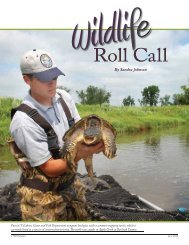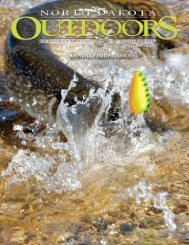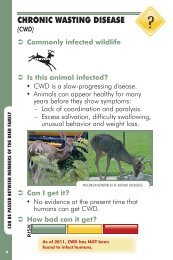Seroma in Animals
Seroma in Animals
Seroma in Animals
You also want an ePaper? Increase the reach of your titles
YUMPU automatically turns print PDFs into web optimized ePapers that Google loves.
SEROMA (Hydrocyst) Commonly <strong>in</strong>fected wildlifeANYMAMMALYOU CAN’T GET IT Is the animal <strong>in</strong>fected?• Yellow or reddish clear fluid under sk<strong>in</strong> orwith<strong>in</strong> muscle.• Can be large (football-sized), and conta<strong>in</strong>more than a gallon of fluid.– Often present between front legs.– Can cause animal difficulty <strong>in</strong> mov<strong>in</strong>g.– Affected animals may be easier prey.AB FISH AND WILDLIFE Can I get it?• NO– <strong>Seroma</strong>s are NOT <strong>in</strong>fectious. How bad can it get?RISKNo risk to humans.42
Protect myself and others• Trim away affected tissue – it isunappetiz<strong>in</strong>g and should not beeaten.– Once affected tissue has beentrimmed away, the meat can be cookedand eaten.– Any meat surround<strong>in</strong>g a seroma is safeto eat.• ALWAYS practice good hygiene bywash<strong>in</strong>g hands with soap and waterafter handl<strong>in</strong>g any wild animal. Symptoms <strong>in</strong> humans• None – people are not at risk.• The fluid <strong>in</strong>side a seroma is not dangerousto human health. Safe for pets?• Yes– After trimm<strong>in</strong>g away affectedtissue.PETS What causes it?• Localized soft-tissue <strong>in</strong>jury.– Not caused by an <strong>in</strong>fection.– Does not conta<strong>in</strong> “pus”.• Fluid (blood serum) seeps from t<strong>in</strong>y rupturedblood vessels <strong>in</strong> <strong>in</strong>jured areas.– Fluid accumulates, often under thesk<strong>in</strong>, and dra<strong>in</strong>s away after some time.TRIM AWAY AFFECTED PARTS43
















